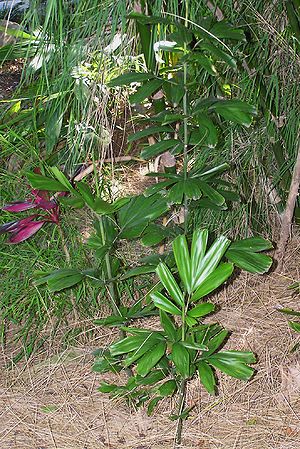Pronunciation: CAL-uh-muss carry-uh-TOY-deez
Common Name: Fishtail Lawyer Cane, Wait-a-While Palm
Calamus caryotoides is one of hundreds of Calamus species, only which a small handful have been ever tried in California. This is a miniature, understory species that is relatively easy to keep in check and avoid the spiny trunks common to all these rattan palms. However this still have hooked, sharp flagella that can easily hook onto skin or clothing of passers-by, so these should be trimmed, or the palm planted well away from pathways. This is probably the most commonly grown of the Calamus in California, but is still a very rarely grown palm.
|
Appearance and Biology
- Habit: multiple; climbing pinnate palm with up to several dozen leaves along the stem
- Height: 20' maximum probably, but normally much shorter
- Trunk: multiple, closely suckering; 1/4"-1/2" thick; spiny with relatively short spines for a Calamus (less than 1/4"); stems winding and curving leaning on surrounding objects and vegetation, or otherwise short and upright; leaves along much of stem length, but also several 3'+ long, hooked flagella between each leaf (used for hooking onto vegetation). It is a surprisingly cold hardy palm considering its near equatorial origins of northeastern Australia
- Crownshaft: none
- Spread: can spread nearly as far as is tall (3' to well over 10')
- Leaf Description: pinnate; short (1', to 18" at the most); with 3"-4" leaflets, fairly widely spread and premorse-tipped; bright green; very tiny, hair-like 3-4mm spines along the proximal edges of the leaflets; leaves spread out along the stems about every 6"
- Petiole/Leaf bases: petioles <1" to non-existant
- Reproduction: dioecious
- Inflorescence:
- Fruit: yellowish brown and rarely seen on California palms
|
Horticultural Characteristics
- Minimum Temp: 23F
- Drought Tolerance: poor
- Dry Heat Tolerance: poor
- Wind Tolerance: moderate
- Salt Tolerance: unknown
- Growth Rate: slow
- Soil Preference: moist and rich
- Light Requirement: filtered sun to full shade
- Human Hazards: lots of thin, sharp spines along stems, but it is the hooked flagella that are the most dangerous parts of this palm's anatomy
- Disease or Horticultural Problems: leaflets dry tip in windy and arid conditions
- Transplants?: unknown
- Indoor?: too dangerous for most indoor situations, but probably would survive if given enough humidity
- Availability: very rare, but occasionally appears on specialty palm lists
|








